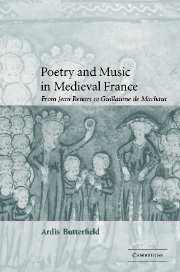
BUTTERFIELD, Ardis, Poetry and Music in Medieval France. From Jean Renart to Guillaume de Machaut
New York, Cambridge University Press (Cambridge Studies in Medieval Literature), 2009, 397 p.
ISBN 9780521100922
RÉSUMÉ
Ardis Butterfield examines the relationship between the poetry andmusic of medieval France. Beginning when French song was first set intowriting in the early thirteenth century, Butterfield describes the widerange of contexts in which secular songs were quoted and copied.Including narrative romances, satires and love poems, the book revealsthe development of French song and narrative genres during asignificant period of history.
TABLE DES MATIÈRES
List of illustrations; List of tables; List of music examples;Acknowledgments; Bibliographical note; List of abbreviations; Prologue;Part I. Text and Performance: 1. Song and written record in the earlythirteenth century; 2. The sources of song: chansonniers, narratives,dance-song; 3. The performance of song in Jean Renart's Rose; Part II.The Boundaries of Genre: 4. The refrain; 5. Refrains in context: a casestudy; 6. Contrafacta: from secular to sacred in Gautier de Coinci andlater thirteenth-century writing; Part III. The Location of Culture: 7.‘Courtly' and ‘popular' in the thirteenth century; 8. Urban culture:Arras and the puys; 9. The cultural contexts of Adam de la Halle; PartIV. Modes of Inscription: 10. Songs in writing: the evidence of themanuscripts; 11. Chante/fable: Aucassin et Nicolette; 12. Writingmusic, writing poetry: Le Roman de Fauvel in Paris BN fr. 146; Part V:Lyric and Narrative: 13. The two Roses: Machaut and the thirteenthcentury; 14. Rewriting song: chanson, motet, salut, and dit; 15.Citation and authorship from the thirteenth to the fourteenth century;Part VI. Envoy: The New Art: 16. The Formes fixes: from Adam de laHalle to Guillaume de Machaut; Epilogue; Glossary; Appendix;Bibliography.